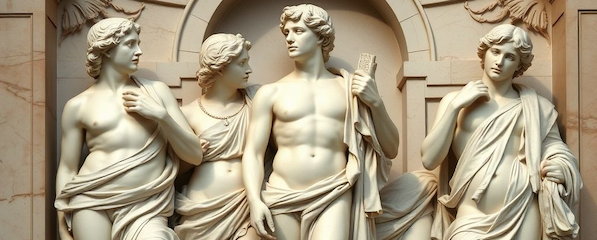
Homoeroticism. Sexual attraction, desire, or eroticism between members of the same sex, particularly as expressed in art, literature, and cultural representations. The term encompasses both explicit and implicit expressions of same-sex desire, often manifesting in artistic works, literary texts, and visual media where homoerotic themes may be subtly woven into narratives or imagery that might not be overtly identified as LGBTQ+ content.
The concept of homoeroticism has been documented throughout human history across diverse cultures and civilizations. Ancient Greek culture, particularly in Athens, celebrated certain forms of male homoeroticism through philosophical and educational relationships between older men and younger students.
Similarly, various forms of same-sex attraction and desire have been represented in art and literature from ancient Rome, Renaissance Italy, and numerous other historical contexts, though interpretations and social acceptance have varied dramatically across time periods and geographical regions.
In contemporary scholarship, homoeroticism is studied through multiple academic disciplines including gender studies, queer theory, art history, and literary criticism.
Scholars examine how homoerotic themes function within broader cultural contexts, analyzing how these representations both reflect and shape societal attitudes toward sexuality and gender identity. The field investigates how homoeroticism operates in works that may not explicitly identify as gay or lesbian content but contain underlying currents of same-sex desire.

Visual arts have long served as a medium for homoerotic expression, from classical sculptures depicting idealized male forms to photography and contemporary art that explores themes of same-sex attraction.
Notable examples include the works of photographers like Robert Mapplethorpe and artists such as Keith Haring, whose creations often incorporated homoerotic imagery and themes.
Renaissance painters frequently depicted biblical and mythological scenes with homoerotic undertones, using religious or classical narratives as vehicles for exploring same-sex desire.
Literature has similarly provided a rich venue for homoerotic expression, with authors embedding same-sex themes within their works through coded language, subtext, and symbolism.
Writers like Walt Whitman, Oscar Wilde, and James Baldwin created literary works that explore various dimensions of same-sex attraction and desire, contributing to the broader understanding of homoeroticism in cultural production.
The study of homoeroticism intersects with broader discussions about censorship, artistic freedom, and social acceptance. Throughout history, works containing homoerotic themes have faced varying degrees of suppression, criticism, and legal challenges, reflecting changing social attitudes toward homosexuality and gender expression. Contemporary discussions often focus on how homoerotic themes in mainstream media contribute to LGBTQ+ representation and visibility.
Modern digital culture has transformed how homoeroticism is expressed, shared, and consumed, with social media platforms and online communities creating new spaces for artistic expression and cultural dialogue around same-sex desire and attraction.